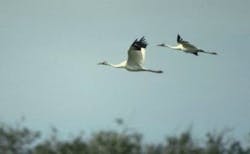The birds, bees, flowers, and trees
Oh yes, and let’s not forget the fish. ITS BREEDING SEASON! For those of you that have inherited projects with regulatory agency permits, it is imperative that you respect the Breeding/Nesting season beginning March 15 through September 15th.
In addition to the birds that reside in each of the 50 States, both Federal and State Regulatory Agencies have jurisdiction over migratory birds and administer the “Rules and Regs” of the Migratory Bird Treaty Act of 1918 (MBTA) for the migrating birds’ protection: US Fish and Wildlife Service and State Regulatory Agencies, e.g., in California it is the California Department of Fish and Game (CDFG).
The original statute (MBTA) implemented the Convention between the United States and Great Britain (for Canada) that took place in 1916 to protect migrating birds between the U.S. and Canada. Amendments to the MBTA have implemented additional treaties between the U.S. and Mexico, the U.S. and Japan, and the U.S. and the Soviet Union (Now Russia)2 to protect migrating birds between the U.S. and these countries.
According to the US Fish and Wildlife Service Migratory Bird Program, “The program’s units – Division of Migratory Bird Management, Division of Bird Habitat Conservation, Regional Migratory Bird Programs and Office of Aviation Management – work together and with other partners to assess, manage and conserve over 800 native migratory bird species and their habitats.”1
Here are the Laws the Program Administers:
- Migratory Bird Treaty Act of 1981 (16 U.S.c. 703 et seq.)
- Fish and Wildlife Conservation aCt as amended (16 U.S.C 2901-2911)
- Bald and Golden Eagle Prote3ction Act of 1940 (16 U.S.C 668-668d)
- North American Wetlands Conservation Act of 1989, as amended (16 U.S.C. 4401-4412)
- Neotropical Migratory bird Conservation Improvement Act of 2000 as amended (16 U.S.C 6101)
- Migratory Bird Hunting and Conservation Stamp Act of 1934 as amended (16 U.S.C 718-718j)
- Junior Duck Stamp Conservation and Design Program Act of 1994, (16 U.S.C. 719)
If you think compliance with these Rules and Regs isn’t a serious matter, think again. According to the USFWS Program Fact Sheet, the USFWS Program spends an aggregate of $86,670,000 on the various components of the Program some of which include: Conservation & Monitoring, Permits, North American Waterfowl Management Plan (Joint Ventures), Duck Stamp Office, North American Wetlands Conservation Act Grants, Neotropical Migratory Bird Conservation Act Grants, and Migratory Bird Staff in 9 Regions.
Specific provisions in the Migratory Bird Treaty Act of 1918 include, “…unless permitted by regulations to, pursue, hunt, take, capture, kill, attempt to take, take, capture or kill, possess, offer for sale, sell, offer to purchase, purchase, deliver for shipment, ship, cause to be shipped, deliver for transportation, transport, cause to be transported, carry, or cause to be carried by any means whatever, receive for shipment, transportation or carriage, or export, at any time, or in any manner, any migratory bird, included in the terms of the 1981 statute… for the protection of migratory birds…or any part, nest, or egg of any such bird.” (16 U.S.C. 703). 2
The penalties violating the MBTA are stiff. The penalties for the taking of migratory game birds by the aid of bait if the person “knows or reasonably should have known” that the area is baited; placing or directing the placement of bait on or adjacent to an area for the purpose of taking or attempting to take migratory game birds are: $100,000 for individuals and $200,000 for organizations, imprisonment for not more than 1 year, or both. The fines for misdemeanor convictions under the MBTA are up to $15,000. The individual States also have regulations, and penalties for violating their regs, to ensure against the taking of endangered and protected species.
So, in managing your real estate assets during this year’s breeding and nesting season, be mindful of all State and Federal Rules and Regs concerning your development. I would highly recommend that you obtain the appropriate consultants to assist you in understanding your existing entitlements, and regulatory agency permit conditions.
Simply put, “it is illegal to “Take” migratory birds, their nests, feathers or nests.”3
If you are unfamiliar with how these Rules and Regs affect your development, I would be glad to answer questions you may have. You can send me an email at: [email protected]
1 Reference: United States Fish and Wildlife Service Migratory Bird Program Conserving America’s Birds, Last Updated December 9,2010, Migratory Bird Management Fact Sheet, Migratory Bird Program, Program Overview
2 Reference: Digest of Federal Resource Laws of Interest to the U.S. Fish and Wildlife Service, Migratory Bird Act of 1918
3 Reference: http://www.fws.gov/pacific/migratorybirds/mbta.htm


